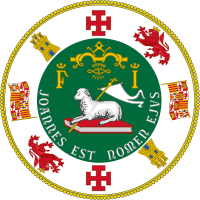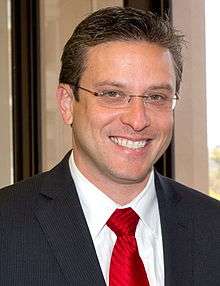2012 Puerto Rican general election
The Puerto Rico general election of 2012 were held on Tuesday, November 6, 2012 to elect the officials of the Puerto Rican government that would serve for the next four years, most notably the Governor of Puerto Rico.[1] A status referendum was held on the same date.
| ||||||||||||||||
| Turnout | 78.19% | |||||||||||||||
|---|---|---|---|---|---|---|---|---|---|---|---|---|---|---|---|---|
| ||||||||||||||||
 Results by municipality Padilla: 40-50% 50-60% Fortuño: 40–50% 50–60% | ||||||||||||||||
| ||||||||||||||||
| Part of a series on |
 Elections in Puerto Rico |
|---|
|
|
Democratic primaries
|
|
Republican primaries
|
|
The election was won by then-Senator Alejandro García Padilla (from the Popular Democratic Party), who defeated incumbent Governor Luis Fortuño (from the New Progressive Party) in a close election.
Significance
The 2012 Puerto Rican election was historic because:[2]
- it was the second time in more than 40 years that six parties participated in the election.
- it was the first time in more than 60 years that a status referendum was held on the same day as the general election.
- it was the first time in Puerto Rico that absentee ballots were issued for those who were out of the country on the day of the election.
Also historically significant was the manner in which Fortuño was defeated. He won in 2008 by nearly 225,000 votes, yet lost in 2012 by nearly 11,000.
Nominations
Before the election year, the Constitution of Puerto Rico provides for any qualified person to present their candidacy for a specific position. If two or more candidates from the same party present their candidacy for the same position, and they can't reach an agreement within the party, a primary election is held. This election is held within the inscribed members of each party, to select which of the candidates will represent the party in the general election.
Both of the main parties: New Progressive Party (PNP) and Popular Democratic Party (PPD), held primaries for several positions on March 18, 2012.
New Progressive Party (PNP)
The primaries were held on March 18, 2012 to determine several candidates for the Senate, House of Representatives, and others.
Popular Democratic Party (PPD)
The primaries were held on March 18, 2012 to determine several candidates for the Senate, House of Representatives, and others.
Final candidates
Governor
The incumbent Governor, Luis Fortuño, from the New Progressive Party (PNP), faces the following candidates for the Governorship:
- Alejandro García Padilla, Popular Democratic Party (PPD)
- Juan Dalmau Ramírez, Puerto Rican Independence Party (PIP)
- Rogelio Figueroa, Puerto Ricans for Puerto Rico Party (PPR)
- Arturo Hernández, Movimiento Union Soberanista (MUS)
- Rafael Bernabe Riefkohl, Working People's Party of Puerto Rico (PPT)
Resident Commissioner
The incumbent Resident Commissioner of Puerto Rico Pedro Pierluisi, from the New Progressive Party (PNP), faces the following candidates for the position:
- Rafael Cox Alomar, Popular Democratic Party (PPD)
- Juan Mercado Nieves, Puerto Rican Independence Party (PIP)
- Sadiasept Guillont Juarbe, Puerto Ricans for Puerto Rico Party (PPR)
- María de Lourdes Guzmán, Movimiento Union Soberanista (MUS)
- Félix Córdova Iturregui, Working People's Party of Puerto Rico (PPT)
Senate of Puerto Rico
At-large
The ballot featured sixteen (16) candidates from six different parties and one independent candidate (bold denotes incumbent candidates)
|
|
District
|
|
House of Representatives
At-large
The ballot featured sixteen (16) candidates from six different parties and one independent candidate (bold denotes incumbent candidates)
|
|
Election results
Governor
| Candidate | Political party | Popular vote | Percentage | |
|---|---|---|---|---|
| Alejandro García Padilla | PPD | 896,060 | 47.73% | |
| Luis Fortuño | PNP | 884,775 | 47.13% | |
| Juan Dalmau Ramírez | PIP | 47,331 | 2.52% | |
| Rafael Bernabe | PPT | 18,312 | 0.98% | |
| Arturo Hernández | MUS | 10,523 | 0.56% | |
| Rogelio Figueroa | PPR | 6,668 | 0.36% | |
| Others | 13,386 | 0.71% | ||
The candidate from the Popular Democratic Party (PPD) Alejandro García Padilla narrowly beat the incumbent Luis Fortuño, from the New Progressive Party (PNP). The margin of victory was 0.7% (or 11,049 votes) which would make it the second closest election in the island in the last 20 years. The candidates of the minority parties all received less than the required 3% to remain registered. Notably, Rogelio Figueroa (from the PPR) received only 6,508 (0.35%) after receiving 53,693 (2.76%) in the 2008 general elections.
Resident Commissioner
| Candidate | Political party | Popular vote | Percentage | |
|---|---|---|---|---|
| Pedro Pierluisi | PNP | 905,066 | 48.44% | |
| Rafael Cox Alomar | PPD | 881,181 | 47.16% | |
| Juan Mercado Nieves | PIP | 38,941 | 2.08% | |
| Félix Córdova Iturregui | PPT | 13,120 | 0.70% | |
| María de Lourdes Guzmán | MUS | 11,764 | 0.63% | |
| Sadiasept Guillont Juarbe | PPR | 5,647 | 0.30% | |
| Others | 12,761 | 0.68% | ||
The incumbent Pedro Pierluisi, from the New Progressive Party (PNP) defeated the candidate from the Popular Democratic Party (PPD), Rafael Cox Alomar. Pierluisi managed to be reelected, despite the fact that his ballot partner, Governor Fortuño, lost against the PPD candidate. This would be the second time in the last 10 years were the Governor and the Resident Commissioner come from different parties. The first one was after the 2004 elections where PPD candidate Aníbal Acevedo Vilá narrowly won the election, while Fortuño (PNP) was elected Resident Commissioner.
Senate of Puerto Rico
| Category | PPD | PNP | PIP | PPR | MUS | PPT | Sub-total |
|---|---|---|---|---|---|---|---|
| By district | 12 | 4 | 0 | 0 | 0 | 0 | 16 |
| By accumulation | 6 | 4 | 1 | 0 | 0 | 0 | 11 |
| Total | 18 | 8 | 1 | 0 | 0 | 0 | 27 |
| Percentage |
The Popular Democratic Party (PPD) won a majority of seats in the Senate of Puerto Rico, with a total of 18 out of 27. The New Progressive Party (PNP) won a total of 8 seats, while the Puerto Rican Independence Party (PIP) won one seat. The PPD won the majority after two terms of being a minority. The election of a senator from the PIP also comes after one term with no senator seated. The PPD won six (6) of the Puerto Rico Senatorial districts. The PNP won only two (2) districts, despite winning all eight during the previous election.
Puerto Rico House of Representatives
| Category | PPD | PNP | PIP | PPR | MUS | PPT | Sub-total |
|---|---|---|---|---|---|---|---|
| By district | 22 | 18 | 0 | 0 | 0 | 0 | 40 |
| By accumulation | 6 | 5 | 0 | 0 | 0 | 0 | 11 |
| Total | 28 | 23 | 0 | 0 | 0 | 0 | 51 |
| Percentage |
The Popular Democratic Party (PPD) also won a majority of seats in the Puerto Rico House of Representatives, with a total of 28 out of 51. The New Progressive Party (PNP) won a total of 23 seats. The other minority parties won no seats. Like with the Senate, the PPD won the majority after two terms of being a minority.
Mayoral
| PPD | PNP | PIP | PPR | MUS | PPT | Total |
|---|---|---|---|---|---|---|
| 47 | 31 | 0 | 0 | 0 | 0 | 78 |
The Popular Democratic Party (PPD) won a majority of the mayoralty races in the island, with a total of 46 out of 78 municipalities. The New Progressive Party (PNP) won a total of 31. One of the most notable races featured PPD candidate Carmen Yulín Cruz defeating incumbent Jorge Santini (PNP) for the mayoralty of the capital city of San Juan after 12 years in the seat.
References
- "Electoral Calendar - international elections world elections". Retrieved 2011-05-12.
- Díaz, Carmen (June 24, 2012). "Elección para la historia". El Vocero.

